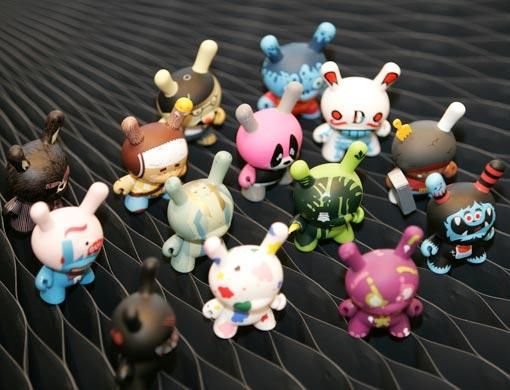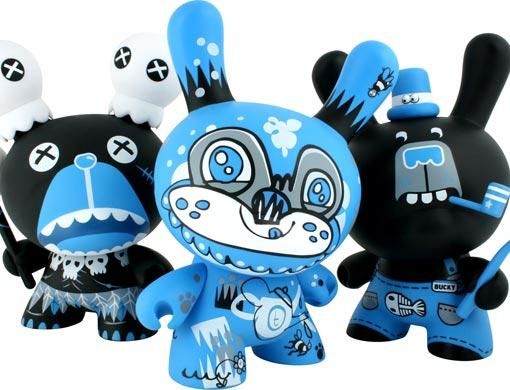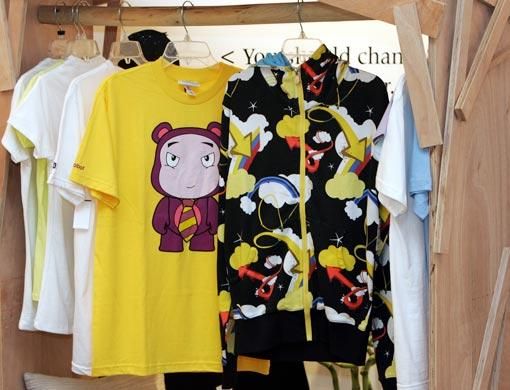At first, Dunny and Munny, the two bestselling characters by Kidrobot, the creator of premier art toys, fashion apparel and accessories, look like regular toys.
At least, until you find out that the Museum of Modern Art (MoMA), New York, acquired 10 Dunny and three Munny toys last year, which are on view till November this year.
Then there is the report of how one Dunny – designed by artist Joe Ledbetter for Kidrobot – recently sold out in 12 minutes online. And another Stuban Crystal Dunny sold for $24,000.
And it is not only Kidrobot's first two characters that have been in the news. In 2006, Kidrobot's toys were the centrepieces at the Cooper-Hewitt Smithsonian Museum Design Triennial in New York City. This year, Christie's, the world's leading auction house, will auction a few older Kidrobot characters in New York.
Dunny and Munny, soft vinyl figurines which resemble cartoon animals based on urban graffiti and stencil art, were created in 2002 by Paul Budnitz, president and founder of Kidrobot, and Tristan Eaton, graffiti artist, illustrator and toy designer.
The vertiginous rise of this designer toy brand has been fuelled by a mix of aesthetic movements ranging from urban street trends, fashion, cartoons, graffiti, art, comics and music.
Paul, who studied photography, sculpture and film at Yale University and lives in New York City, was thrilled when MoMA approached Kidrobot for versions of Dunny and Munny painted by some of the best artists.
"It was fantastic when they said they wanted a few of our toys. It was a kind of establishment acceptance of the work we're doing. It is fun to see our pieces in the museum," he says.
Kidrobot operates through store-galleries in New York City, San Francisco, Los Angeles and Miami and through the Dubai-based concept store, Five Green.
Kidrobot toys are considered both toys and art. "Selling them is part of the artwork too," says Paul, author of I am Plastic: The Designer Toy Explosion.
Many Kidrobot's limited-edition toys, which retail from $6 and upwards, are rare and collectible. "Toy artists often choose to produce in editions of 800-500 to even 50 pieces. So once they are gone, they are gone. Collectibles are often sold for hundreds or thousands of dollars,"
he says.
Art toys, an alternative culture
It is the artistic value that elevates the status of a regular toy to a designer or collectible. The Kidrobot toy line-up, which includes Zoomies and MoochyPooty characters, is edgier than what most would think of as toys.
Paul has been quoted describing his designs as folk art, something that exists on the fringes of modern culture. Yet, he admits, Kidrobot enjoys mainstream popularity and is in keeping with trends. "I believe this art form has emerged from pop culture.
It uses various popular references like fashion design and fine art." The defining aesthetics of Kidrobot toys are bright colours and vinyl, though they are manufactured in other plastics, metal and wood.
Many Kidrobot characters are influenced by classic European and Japanese toys that Paul obsessed over as a kid growing up in California. "So there are monsters as well as cute animals. There's always a little cuteness and a little darkness about them," he says.
Kidrobot has always maintained a philosophy of collaboration on toy projects. (Roughly 60 projects each year.) Paul has worked with hundreds of artists: graffiti artists like Doze Green, Dalek, Mist and Tilt; cutting-edge illustrators like Frank Kozik and Tara McPherson; and fashion designers like Marc Jacobs, Paul Smith and Hermes.
"When someone designs a toy with us, it's really a co-production, an artist's art mixed with our aesthetic," says Paul.
The Kidrobot story
The artistic movement of toys began with the popularity of limited-edition designer toys and the urban vinyl movement about 10 years ago.
According to Paul, a few artists like Michael Lau in Hong Kong began making limited-edition toys. Michael began showing up at toy-trading conventions with handmade toys. (Michael is credited as the founder of the urban vinyl style within the designer toy movement.)
"Basically Michael took GI Joes and other military figures, cut off and recast heads and hands, and then sewed up his own clothing to make very stylised hip-hop figures. He even made boxes out of hand-cut cardboard.
At the same time, a small Gothic clothing store in Japan named Bounty Hunter began producing limited-edition vinyl toys based on American cereal box characters to complement their clothing lines," he says.
Paul saw these edgy vinyl toys coming out of China and Japan. He realised that people were visiting China to convince factory owners to use the same machinery that mass-produces toys to make limited-edition works of art.
He had the gumption to do the same, resulting in Kidrobot.
"It's just brilliant and a little mischievous to use the factories that make mass life-deadening culture to do something cutting-edge. That's what I wanted to do when I founded Kidrobot in a garage in California," he says.
The name, Kidrobot, invoked just the mood he wanted – playful and sort of twisted. "If you look at our logo character, the Kidrobot himself, he has a sort of Mona Lisa smile. If he has a flower in his hand he looks cute and friendly, but when he has a crowbar in his hand he looks like he's about to hijack your car," he laughs.
When Paul started out, he had no money. The most difficult part was to stay in business and learn to make his own toys and open stores. Luckily, the toys turned out to be popular, so he now spends money on opening new stores like the one in Toronto this year.
"In the beginning I didn't know if we would survive!" he says, admitting, "It was also hard to market. People would say, 'You're selling what?' It was hard for them to grasp at first, until they'd walk into a store and say, 'Oh! I have to own that!'" Kidrobot stores don't resemble toy stores.
Rather they are inspired by museum design. Paul, who co-designed all of Kidrobot's retail stores, says, he is also inspired by design stores like Moss in New York and he loves Disneyland. "It [Disneyland] may be tacky, but it really makes you feel different when you are there.
I wanted to create a new environment. Toys are placed behind glass to reinforce the idea of quality, uniqueness and preciousness. The space is modern, clean, and then – bam! – there's the bright element like a vinyl patterned wall that is changed every few months."
The design process
At Kidrobot, the design process of a toy from conceptualising to production is different every time. Sometimes, Paul has an idea, and he calls an artist. "I then suggest we do something together. Or sometimes someone comes to us.
In any case, we start with sketches, models, production samples, and at each stage we go back and forth until everyone is satisfied that the design is undeniable. I never worry about running out of ideas; if something doesn't work I kill it and move on. I'm pretty famous for killing a project at the last stage if it isn't working," he says.
Paul enjoys the process of collaboration with in-house and freelance artists. He says you always make greater work when you're open and willing to get your ego out of the way. "We often insist that artists we work with open up and let us influence them and vice versa," says Paul, who often keeps toys that he has been given by toy artists or those that inspire him.
As the creative director, all designs are filtered through him. "I come up with ideas that turn into products. At the same time, I'm involved with how we run the company because in many ways the culture behind what we do and how we do it is the art form of Kidrobot itself," he says.
Blurring demographic market segments
Some trend analysts argue that adults purchasing toys is a kind of paedomorphism, and they voice that there should be separate toys for children and adults.
To this, Paul reasons, "Toys have universal applicability. Kids play with our toys. At the same time, adults collect them as works of art. Toys are bought because they are beautiful.
I believe we're working with icons and archetypes, so it applies to everyone." When Paul was younger, he loved GI Joes, especially when he had firecrackers and bottle rockets to tie them to. "I was a pretty destructive kid," he says.
He also enjoyed Playmobil, Brio wooden toys and giant vinyl toys from Japan bought in Chinatown in Oakland, California.
"I am an ardent fan of Bounty Hunter, and have just about everything ever made," he says.
Geographically, the toy market is universal. Take Dubai for instance. "It's so exciting that Dubai is into Kidrobot now. For me Dubai represents the ultimate example of international culture being applied and re-applied without worrying about where the design came from. I see Dubai as a work of art that is similar to Kidrobot in many ways. Dubai is like a living and breathing Pop Art piece," he says.
How Dunny and Munny got famous
Dunny and Munny were created in 2002 by Paul Budnitz, president and founder of Kidrobot, the world's premier creator of art toys and Tristan Eaton, graffiti artist, illustrator and toy designer.
"The idea was to give the toy to an artist or designer and ask him to paint and design the box with us. We would then produce and sell a limited quantity," says Paul.
After a while Paul noticed that people were buying 8-inch (20 cm) Dunny toys, repainting them, and then selling them as one-of-a-kind toys on eBay.
In fact, a very rare Dunny sold for $40 can fetch hundreds or thousands of dollars on the internet. "So we created Munny as a do-it-yourself relative of Dunny. With Munny you get to make the toy yourself," he says.
You can see all the Dunny designs ever produced on the Kidrobot website. "There are hundreds at this point, and they come in different sizes; small [3 inches or 7 cm], medium [8 inches or 20 cm], and large [20 inches or 50 cm]. We have made a few six-foot versions for art shows," he says.
Kidrobot's diversification
Apart from toys, Kidrobot has a very successful clothing line too, retailed in boutiques worldwide including Barneys New York and the Dubai-based concept store Five Green. In 2006, Paul co-designed much of Kidrobot's acclaimed limited-edition apparel line.
(Clothing pieces are priced between $175 and $3,000.)
"Many of our clothing pieces are limited edition. I love fashion. The more I made toys, the more I wanted to 'be' one of our toys. So I figured, what would a toy wear? We invented clothing that represents us, and it sells out very quickly, so it seems that other people like the idea too," says Paul.















